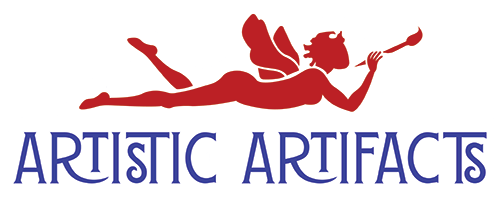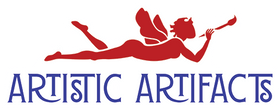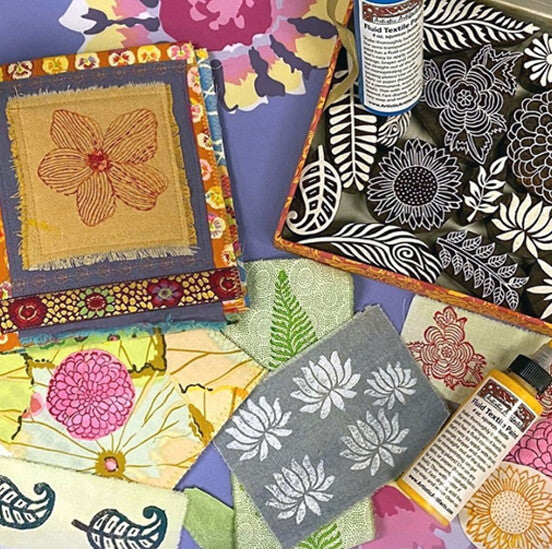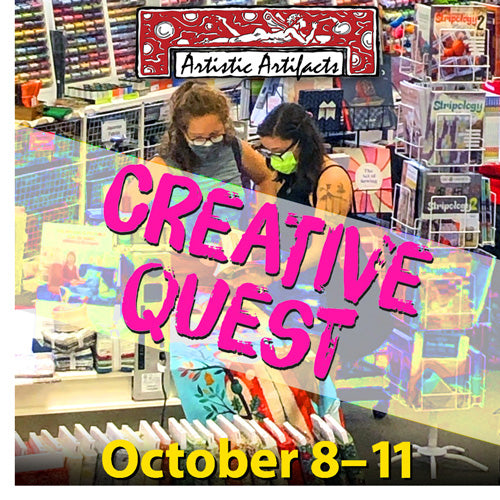The Printed Fabric Bee
As noted last week, I’m now a member of the Printed Fabric Bee, a collaboration of professional textiles artists printing fabric collections for each other. Each month a member of the “Hive” chooses a theme, making her the “Queen Bee,” and we all create a piece of fabric based on her choices. While the Queen Bee receives a collection of custom-made fabric, anyone has the opportunity to win a 6 × 6 swatch collection of the monthly themed fabrics simply by leaving a comment (you have until November 17 to do so, don’t miss out!) on the Printed Fabric Bee blog,
As promised, I am updating this posting with details on how I created my fabric for the October theme of Science, which was chosen by Jackie Lam. The full list of participant links is at the bottom of this post, so please visit to learn about how they made their beautiful fabrics.
I still had a couple of days warm enough to dye with my Indigo Vat. As a new member of the Printed Fabric Bee, I did not want to be late with my first sample! So I was aiming for fabric that was quick and easy, and decided that I would do some shibori. (Little did I know that I only had to create ONE 12" x 12" square and ONE 6" x 6" square for the give away!)
First I acquired my tools: the largest dried bean in the grocery store and the smallest rubber bands, pictured here. I think that is a lima bean, my white fabric, and the tiny rubber bands I found in the hair care aisle. (I remember these rubber bands from braces, way back when!)
I manipulated the fabric to create a small pouch that could hold the bean, and “tied it off” with using the tiny rubber band, wrapping the rubber bands closely to the bean. I did this repeatedly, in a random fashion, across all of my fabric. Pictured below is my fabric before immersion in the indigo.
I then placed the fabric in my vat of indigo dye for 20 minutes. Part of the fun with indigo dyeing is that when you pull your fabric out of the vat, it is initially a bright lime-green color. Once the fabric hits the air, the oxidation process turns the indigo the traditional blue. It happens quickly, and watching it is always fun. For a deeper color blue, you can leave your fabric in the dye longer, or you can also place in the vat repeated times. My fabric sample was “dipped” twice.
Above is the fabric after dyeing and with the beans and bands removed. I had some difficulty removing the tiny rubber bands, and so resorted to a small pair of scissors. I held my breath doing so, so that I did not cut into the fabric! The difference in the patterns you see side by side was due to the size of the bean, and how the fabric was folded for the rubber band. I really did not pay attention to this, so the difference was a surprise to me.
Once the fabric was dried, I washed it twice in hot water, using a bit of Synthrapol, which can be used before (will remove sizing from fabric), during (can be used in certain dye bath for even color) and after (will remove excess dye), the dyeing process.
Now my cosmic starburst fabric was ready for a bit of sparkle. I used Bo-Nash Fuse It Powder (a granular fusible) that I sprinkled around the shibori star burst patterns, and then ironed foil to the fabric. The result was a wonderful twinkling effect of tiny points of reflection. (Click the photo for a larger view.)
 So, not only did I use science to create the fabric (the chemical process of dyeing with indigo) the look of the fabric was inspired by a field of science, astronomy.
So, not only did I use science to create the fabric (the chemical process of dyeing with indigo) the look of the fabric was inspired by a field of science, astronomy.
Jackie Lam on her theme: “I have been fascinated with the design of anything at a microscopic level. Different objects, plants, chemicals, you name it, all have unique and beautiful designs when you look at them through a microscope. Check out my Pinterest board to see what I mean. So I figured that would be a fun challenge for the gang in the Printed Fabric Bee to translate that into a surface design idea. My only conditions were no pastels and 12×12. And wow, I have been getting very cool fabric in the mail every few days and it has been awesome. There have been a lot of ‘oohs and ahhs and cool!’ from the kids in the house as well since it’s a subject they really enjoy too.”
Remember, leave comment at Printed Fabric Bee blog before November 17th for your chance to win the fabric swatches. Visit these websites to learn how each member made her fabric:
- Deborah Boschert
- Lisa Chin
- Gerrie Congdon
- Jane Davila
- Carol R. Eaton
- Lynda Heines
- Leslie Tucker Jenison
- Lynn Krawczyk
- Jackie Lams
- Susan Purney Mark
Click the below image for a larger view of these scientific beauties!












Leave a comment